Mad Hedge Biotech and Healthcare Letter
February 4, 2025
Fiat Lux
Featured Trade:
(TOO RICH TO FAIL, TOO EXPENSIVE TO SUCCEED)
(MRNA), (TSLA), (NVS), (SNY), (JNJ), (BNTX), (RHHBY), (REPL), (CRSP), (ORCL)

Mad Hedge Biotech and Healthcare Letter
February 4, 2025
Fiat Lux
Featured Trade:
(TOO RICH TO FAIL, TOO EXPENSIVE TO SUCCEED)
(MRNA), (TSLA), (NVS), (SNY), (JNJ), (BNTX), (RHHBY), (REPL), (CRSP), (ORCL)

Last weekend, while organizing my home office, I stumbled across an old COVID vaccination card. Remember those? It got me thinking about Moderna (MRNA), the biotech darling that went from relatively unknown to household name faster than you can say "messenger RNA."
Now, in early 2025, this once up-and-coming company is already facing what my grandmother would call "champagne problems" - too much cash to be broke, but burning through it faster than a Tesla (TSLA) on Ludicrous mode.
First, let's talk about this biotech's cash burn. In just nine months of 2024, Moderna torched through over $4 billion - that's the same amount they burned in all of 2023, suggesting their cash cremation rate is actually accelerating.
This acceleration in spending wouldn't be as worrying if they had endless reserves, but their current position shows $7 billion in cash and $2 billion in non-current investments.
The math isn't complex: at this burn rate, their runway is shorter than many investors realize.
The recent Health and Human Services (HHS) grant of $176 million in July 2024 for bird flu research barely registers on their financial statements.
While we've seen about 70 bird flu cases in the U.S. with one fatality in an elderly patient with underlying conditions, this isn't going to be another COVID-style revenue stream.
I've analyzed enough pharmaceutical companies to know that betting on another pandemic windfall is like expecting lightning to strike twice in the same spot.
What really interests me is Moderna's position in the competitive landscape. I spent last week analyzing patent data and geographic reach metrics across the industry.
First, you've got the old-guard pharma giants like Novartis (NVS), Sanofi (SNY), and Johnson & Johnson (JNJ), who have been at this game since before mRNA was a gleam in a scientist's eye.
Then, there are companies like BioNTech (BNTX) and Roche (RHHBY) with significantly higher geographic reach, while Replimune Group (REPL) and CRISPR Therapeutics (CRSP) demonstrate superior application diversity.
In comparison, Moderna's position in this landscape shows relatively low scores on both metrics - not exactly what you want to see from a company burning cash at this rate.
Stéphane Bancel, Moderna's CEO, recently outlined their pipeline: 2 approved medicines, 7 Phase 3 trials, and 45 candidates in development. They're also targeting $1.1 billion in annual R&D cost reductions by 2027.
But here's what keeps bothering me: their SG&A expenses have ballooned to nearly 10 times their pre-COVID levels, yet management is focusing on R&D cuts instead of addressing this administrative bloat.
The insider trading patterns since early 2024 haven't exactly inspired confidence either.
When I see heavy selling from insiders while a company is promising future breakthroughs, I can't help but remember all the biotech stories I've covered where the promise didn't match the reality.
Speaking of promises, Oracle's (ORCL) Larry Ellison recently made headlines talking about 48-hour personalized cancer vaccines using AI and robots.
While the technology sounds promising, I'm more interested in the practical path to profitability. Moderna isn't alone in this race, and their well-capitalized competitors have the luxury of funding similar development programs while maintaining positive cash flow.
Given Moderna's cash burn trajectory, their next three quarters will be telling.
I'll be watching that $4 billion nine-month burn rate closely, along with their progress on cost reductions - particularly those inflated SG&A expenses that management seems reluctant to address.
I'm keeping my old vaccination card as a reminder of Moderna's impressive COVID-19 achievement, but I'm not ready to bet on lightning striking twice.
Sometimes the hardest part of investing is knowing when to appreciate history without banking on its repeat performance.
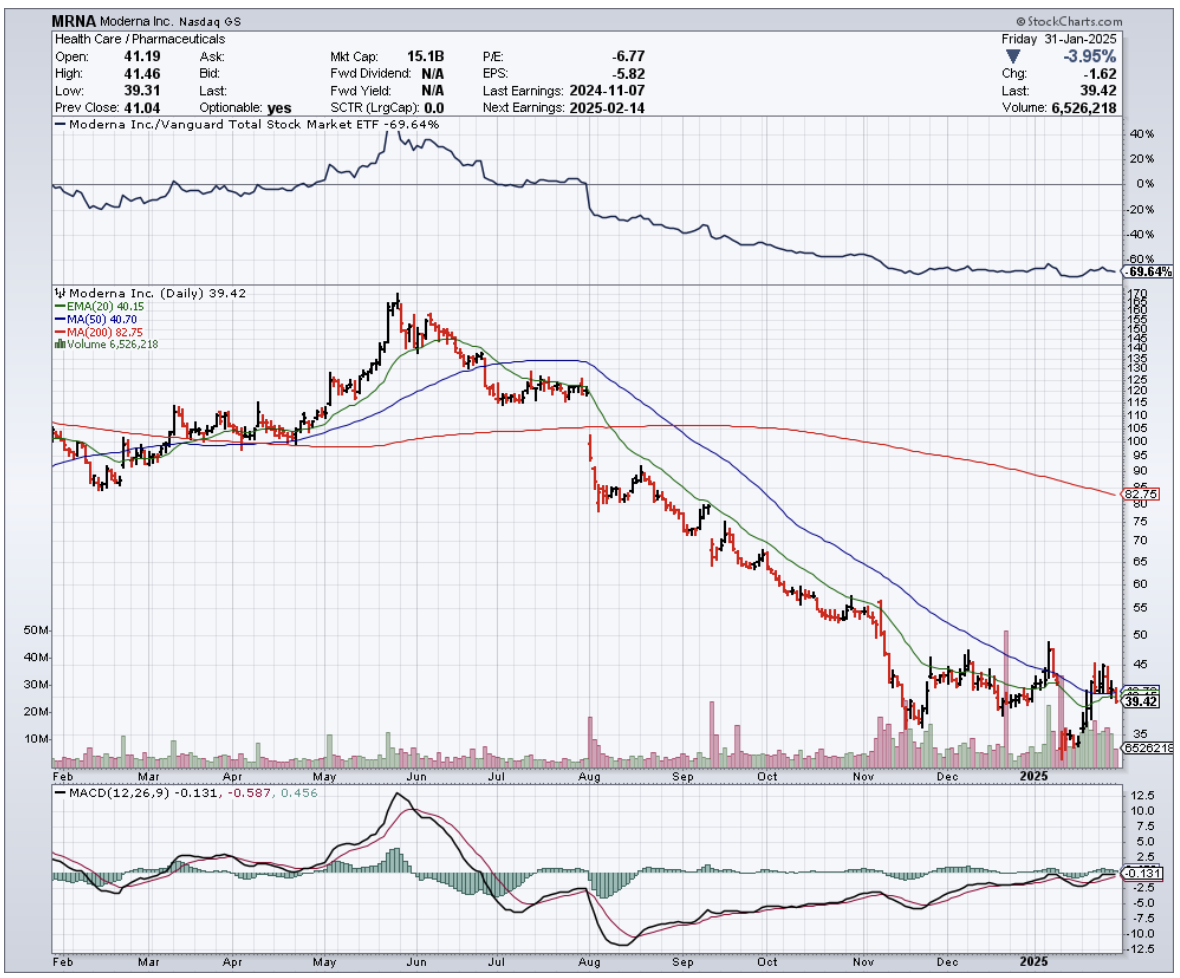
Mad Hedge Biotech and Healthcare Letter
January 28, 2025
Fiat Lux
Featured Trade:
(READY, RESET, GO)
(JNJ), (AAPL), (PFE), (ABBV), (RHHBY), (AZN), (SNY), (NVS)

I had to laugh when I saw Johnson & Johnson's (JNJ) Q4 earnings hit my screen earlier this month.
Here we have Wall Street wringing its hands over a slight revenue miss, sending shares down 3.5%, while management is busy plotting its path to pharma industry dominance.
The numbers tell an interesting story.
Q4 revenues grew 5.3% (or 5.7% on an adjusted operational basis) to $22.5 billion. Wall Street got the vapors because earnings came in at $1.41 per share, well below their $2.04 consensus.
Reminds me of the time analysts completely missed Apple's (AAPL) transformation into a services company.
For the full year 2024, JNJ delivered 4.3% sales growth (5.4% operational) to $88.8 billion, with earnings per share landing at $5.79, or $9.98 adjusted after swallowing a $(0.67) hit from acquired IPR&D charges.
Not too shabby for a company in transition.
Looking into 2025, management is guiding for 2.5-3.5% operational sales growth ($90.9-91.7 billion) and adjusted operational EPS of $10.75-$10.95.
That's 8.7% growth at the midpoint, though they're careful to hedge around legal proceedings and acquisition costs.
And here's where it gets interesting.
During last week's JP Morgan Healthcare Conference, CEO Joaquin Duato was practically bouncing in his chair about their drug pipeline. Let's look at what's got him so excited.
Darzalex, their multiple myeloma superstar, raked in $11.67 billion in 2024, up 20%.
The new kid Carvykti exploded 93% higher to $963 million. Tecvayli landed $550 million in its rookie year.
Depression med Spravato jumped 56% to hit the magic $1 billion mark. Tremfya, their Stelara successor, grew 17% to $3.7 billion.
Speaking of Stelara – there's the elephant in the room.
JNJ's crown jewel is losing patent protection, already showing up in Europe with a >12% sequential decline in Q4 to $2.35 billion. Expect a 30% "haircut" this year.
But here's what Wall Street is missing: JNJ saw this coming years ago.
They just dropped $14.6 billion on Intracellular Therapies, mostly debt-funded (they can afford it with only $31.3 billion in long-term debt and $19.98 billion in cash).
This brings them Caplyta, an antipsychotic med with blockbuster potential that's already approved for schizophrenia and bipolar disorders.
The medical device business isn't sitting still either.
Q4 worldwide revenues jumped 6.7% year-on-year. While Surgery was flat at $2.5 billion and Orthopedics grew a modest 2.5% to $2.32 billion, Vision popped 9% to $1.3 billion.
But the real story? Cardiovascular surged 24% to $2.1 billion. Those Shockwave and Abiomed acquisitions are looking pretty smart right about now.
For the year, MedTech grew 4% to $31.56 billion. Operating margins slipped a bit – Innovative Medicines down from 42% to 39.4%, MedTech from 23.7% to 21.6%.
Late-stage pipeline products nearing approval should ease R&D expenses in 2025, just as JNJ gears up for its next growth phase.
The foundation looks rock solid - $19.98 billion in cash, $31.3 billion in long-term debt, 2025 adjusted EPS guidance of $10.75-$10.95, and that reliable $1.24 quarterly dividend.
But forget the current numbers - the real money's in what's coming next.
Here's what the market is missing: JNJ is promising 5-7% compound annual growth between 2025-2030, with ten drugs hitting $5+ billion in annual sales by decade's end.
Sound ambitious? Maybe. But they've got the pipeline to back it up – from immunology stars nipocalimab and icotrokinra to neuroscience contenders seltorexant and aticaprant, plus oncology plays like TAR-200 for bladder cancer.
I've seen this movie before with AbbVie (ABBV), which navigated the loss of $20+ billion Humira without missing a beat.
And JNJ looks even better positioned - their pharma division is targeting $58 billion in 2024 revenues, which would make them the biggest player in Big Pharma, ahead of Pfizer (PFE), AbbVie (ABBV), Roche (RHHBY), AstraZeneca (AZN), Sanofi (SNY) and Novartis (NVS).
The only real wildcard? That pesky talc litigation.
JNJ's latest move – spinning the lawsuits into Red River Talc LLC and filing for bankruptcy – could cap the damage at $8.5 billion. They claim 75% of claimants are on board, with a court ruling expected this month.
So, what's my take? I think JNJ's 2025 will be a "reset" year, especially the first half. But just like buying straw hats in winter, there might be an opportunity here for patient investors. Management says the back half will be stronger, setting up 2026 for what could be a very interesting guidance call.
While the market frets about Stelara's patent cliff, smart money is quietly building positions. That's why I'm maintaining my stand to buy the dip.
After all, sometimes the best trades are the ones that make you a bit uncomfortable at first. And if you're worried about patent cliffs, just ask any AbbVie shareholder how that worked out for them.
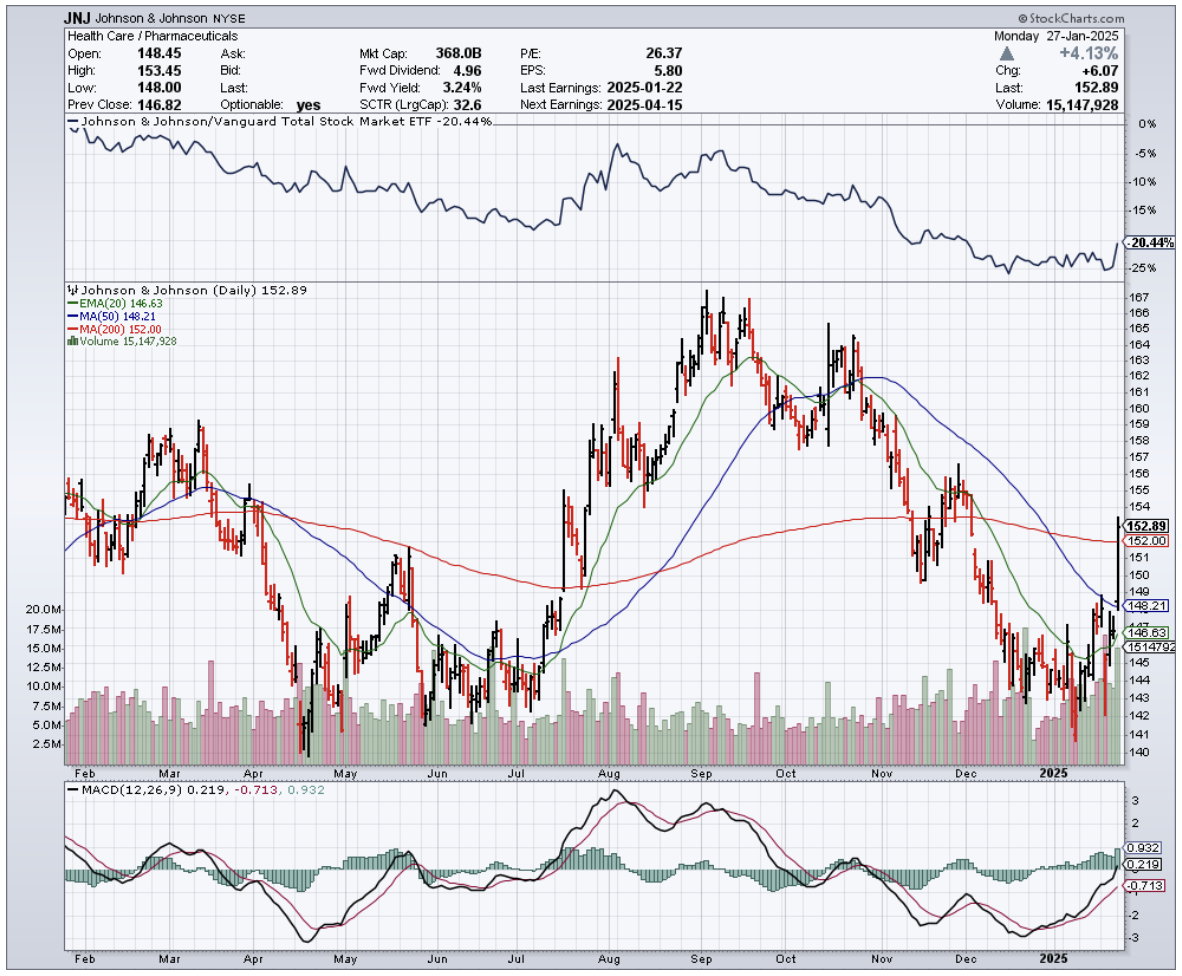
Two scientists walk into a bar. One says, "I've got a funny story about a worm." The other replies, "Hold my Nobel Prize."
This isn't just a setup for a punchline - it's actually a key part of a recent groundbreaking discovery that's just earned Victor Ambros from UMass Chan Medical School and Gary Ruvkun from Harvard Medical School the 2024 Nobel Prize in Physiology or Medicine.
In a nutshell, these two have just been crowned the rock stars of RNA research for 2024 for uncovering the secrets of microRNA. It's like they've found the Rosetta Stone of gene regulation, and boy, is it a game-changer.
Now, you might be thinking, "John, haven't we been down this RNA road before?" And you'd be right. Just last year, the Nobel folks were gushing over mRNA vaccines. But this year's prize? It's a whole different ballgame.
For years, we thought we had gene regulation all figured out. Genes make mRNA, mRNA makes proteins, and proteins run the show. Simple, right? Well, Ambros and Ruvkun just blew that notion out of the water.
Their breakthrough came from an unlikely source - a tiny worm called C. elegans. This little nematode might not look like much, but it's been the workhorse of biology for decades.
Ambros and Ruvkun were puzzling over some mutant worms that couldn't get their growth spurts right. One type was growing too big, the other too small.
After years of head-scratching and late nights in the lab, they stumbled upon something extraordinary. They found that a gene called lin-4 wasn't making a protein at all.
Instead, it was cranking out a small piece of RNA that could stick to another gene's mRNA and shut it down. This was microRNA, and it was about to turn the world of molecular biology on its head.
At first, everyone thought this was just some quirky worm thing. But seven years later, Ruvkun's team found another microRNA that showed up not just in worms but in everything from fruit flies to humans.
Suddenly, microRNA wasn't just a biological oddity - it was a universal regulator of genes.
Fast forward to today, and we now know that humans have over 1,000 different microRNAs. These tiny molecules are pulling the strings on virtually every gene in our bodies. It's like discovering a whole new layer of cellular bureaucracy we never knew existed.
Now, you might be wondering, "That's all well and good, but what's it got to do with making money?" Well, let me tell you, this discovery has set off a gold rush in the biotech world.
Companies are scrambling to turn this basic science into cold, hard cash.
Take Regulus Therapeutics (RGLS), for instance. They're working on a treatment for polycystic kidney disease that targets microRNA-21. It's early days, but the potential is enormous.
Then there's Alnylam Pharmaceuticals (ALNY). These folks have already brought RNA-based therapies to market.
Their drug, ONPATTRO, is treating a rare disease called hereditary transthyretin-mediated amyloidosis. It's proof that RNA-targeted treatments aren't just pie in the sky - they're real, and they're here.
Big Pharma is getting in on the action, too. Roche (RHHBY) bought up a company called Santaris Pharma back in 2014, snagging some nifty technology for developing microRNA therapies.
Novartis (NVS) and AstraZeneca (AZN) are also dipping their toes in the microRNA waters. And let's not forget about Qiagen (QGEN). They're not developing therapies, but they're selling the picks and shovels for this gold rush - tools for microRNA research and diagnostics.
Now, I'm not saying you should go all-in on microRNA stocks tomorrow. This is cutting-edge science, and the road from the lab bench to the pharmacy shelf is long and treacherous. But for those of you with an appetite for risk and a long-term view, this could be the next big thing in biotech.
So the next time someone corners you at a party with a story about microscopic organisms, maybe don't rush to the bar just yet. Remember, Ambros and Ruvkun weren't trying to create the next blockbuster drug. They were just curious about some weird-looking worms. Who would have thought their discovery could end up revolutionizing medicine?
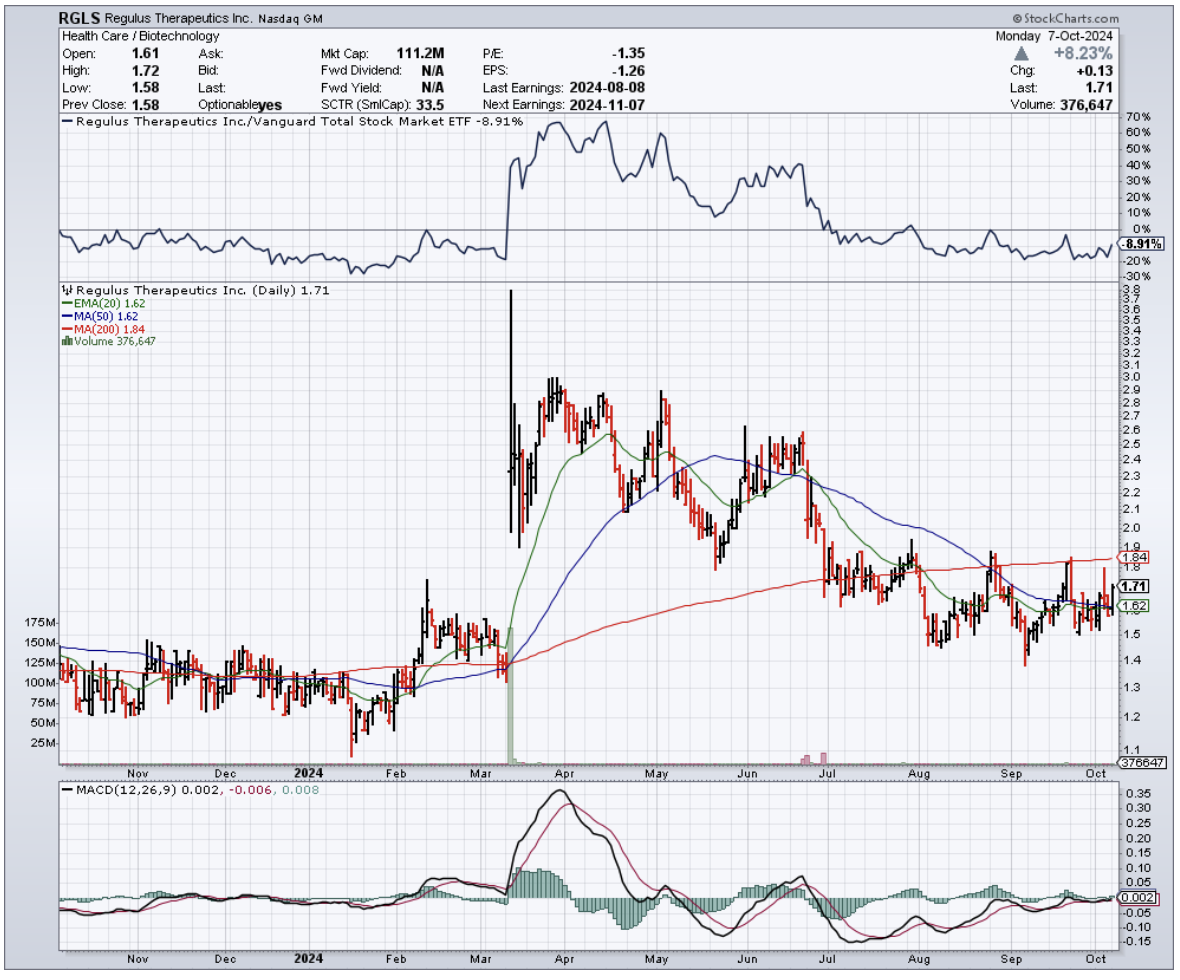
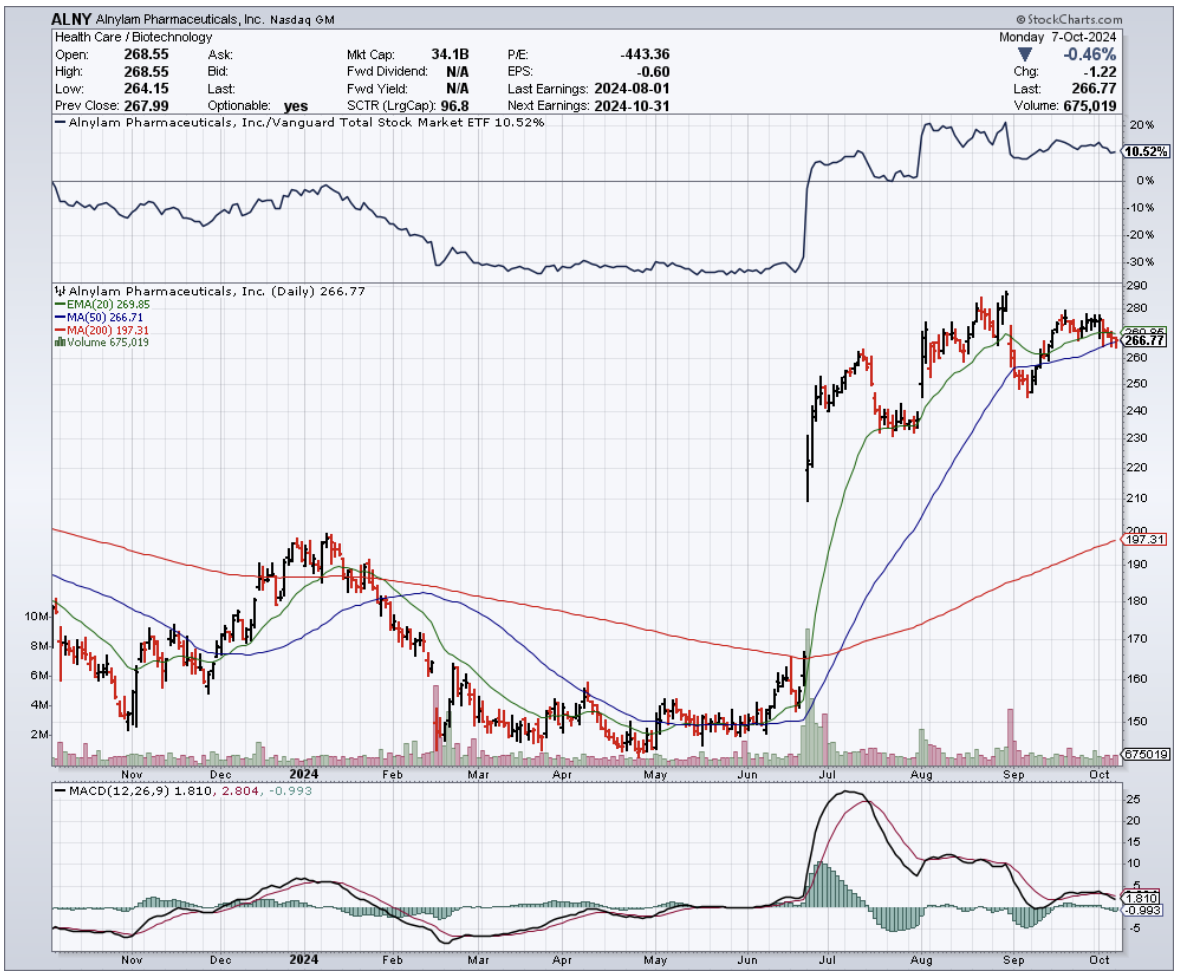
Mad Hedge Biotech and Healthcare Letter
October 8, 2024
Fiat Lux
Featured Trade:
(THE LITTLE RNA THAT COULD)
(RGLS), (ALNY), (RHHBY), (NVS), (AZN), (QGEN)

Mad Hedge Biotech and Healthcare Letter
September 17, 2024
Fiat Lux
Featured Trade:
(A JAB WELL DONE OR A SHOT IN THE DARK)
(MRNA), (RHHBY), (NVS), (BMY)

Moderna (MRNA), the wunderkind of the COVID vaccine era, is facing a bit of a hangover. Remember when this biotech darling was riding high on vaccine sales? Well, those days are looking as distant as your last booster shot.
The company's stock had a decent first half, climbing about 20%. They even scored a win with their new RSV vaccine approval. But hold your horses, because things are getting a bit dicey.
Last month, Moderna had to revise its COVID vaccine revenue downward. Translation: people aren't lining up for jabs like they used to.
And just last week? They dropped another bombshell: Moderna's planning to slash its annual R&D spending by over $1 billion starting in 2027. On top of that, they're also pulling the plug on five programs.
But wait, there's more. Remember when Moderna was supposed to break even in 2026? Well, now they're saying it'll be 2028. That's like telling your date you'll be there in 5 minutes, then showing up two hours later.
Now, let's talk numbers. The consensus for 2025 sales was sitting pretty at $3.9 billion. Moderna's new projection? A potential downside of $2.5 billion, with a best-case scenario of $3.5 billion. As for 2024, they're looking at $3 to $3.5 billion.
And here's another head-scratcher: Despite 800,000 people over 65 in the U.S. being hospitalized last season, only 41% of this population has the COVID vaccine. Compare that to 74% with the flu vaccine. It looks like people trust the old-school flu shot more than the new kid on the block.
So, what's Moderna's game plan? They're focusing on delivering 10 products over the next three years. That's down from their previous bold claim of 15 new products in five years.
Here’s what CEO Stéphane Bancel has to say about this: "The size of our late-stage pipeline combined with the challenge of launching products means we must now focus on delivering these 10 products to patients, slow down the pace of new R&D investment, and build our commercial business."
In other words, they bit off more than they could chew and now they're trying to swallow.
Moderna's slashing its R&D investment for 2025 through 2028 by 20%, down to $16 billion. That's a $4 billion haircut.
But here's the twist - they're actually increasing investment in oncology, presumably to hopefully build a portfolio that could rival the likes of Roche (RHHBY), Novartis (NVS), and Bristol Myers Squibb (BMY).
Now, before you start thinking it's all doom and gloom, let's look at the silver lining.
Moderna expects its respiratory vaccines to be profitable this year and beyond. They're also aiming to file for approval of three new products by year-end: a next-gen COVID vaccine, a combo flu/COVID vaccine, and an RSV vaccine for younger high-risk adults.
Now, is Moderna a buy or a sell? Well, that really depends on your investment style.
Moderna's in a tight spot, but it's not game over. They're trimming the fat, focusing on what works, and betting big on oncology.
Plus, they actually have the cash to see this strategy through. So, they won't need to pass around the collection plate to reach their break-even goal. Their current situation is admittedly not pretty, but it's not a death spiral either.
For most of us, this is where the rubber meets the road. If you're up on Moderna, consider taking some profits, but don't bail completely. This could be a classic "buy the dip" opportunity for the bold.
Remembert, biotech is boom or bust, and Moderna's loaded pipeline needs just one hit to soar. Their combo vaccines could be game-changers if they pan out. And let's not forget, they cracked the mRNA code - that's not small potatoes in the world of drug development.
Bottom line: If you're risk-averse, look elsewhere. But for those with iron stomachs and long-term vision, this might be your chance to snag a potential biotech giant on sale.
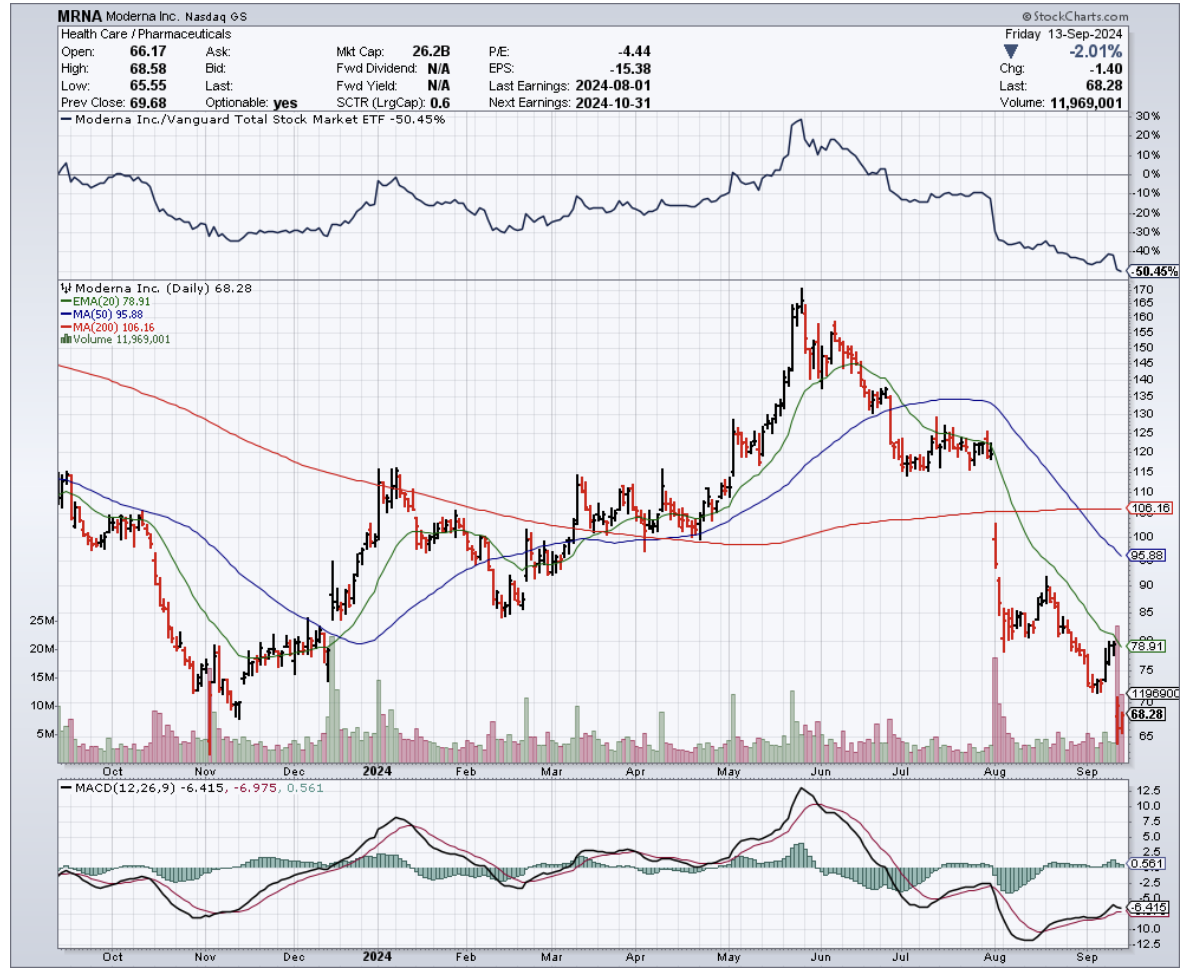
Mad Hedge Biotech and Healthcare Letter
August 29, 2024
Fiat Lux
Featured Trade:
(ONE TEST TO RULE THEM ALL)
(ILMN), (BAYRY), (LLY), (MRK), (BMY), (AZN), (RHHBY), (NVS), (GH), (TEM), (TMO)

“One test to rule them all, one test to find them, one test to bring them all, and in the lab bind them,” the scientists at Illumina (ILMN) whispered – probably.
Their latest creation just got the FDA nod, and it's set to turn the world of cancer diagnostics on its head. It's as if Gandalf himself handed oncologists a palantír that reveals tumors' deepest secrets.
For those less versed in Middle-earth lore, this is like inventing a universal remote for tumor profiling, and oncologists can't wait to start channel surfing.
Now, you might be thinking, "What's the big deal?" Well, let me break it down for you.
This test, called TruSight Oncology Comprehensive (TSO for short), is the first FDA-approved genomic in vitro diagnostic kit that can make pan-cancer companion diagnostic claims.
In plain English, that means it's a single test that can be used across multiple cancer types. We're talking about a game-changer in precision oncology here.
Let's get into the nitty-gritty. This TSO test is a beast. It screens for a whopping 517 genes and provides comprehensive information on tumor mutational burden (TMB) and microsatellite instability (MSI).
These are crucial biomarkers that help determine how a patient might respond to immunotherapies. The breadth of data this single FDA-approved test can collect is unprecedented.
Now, you might be wondering, "Haven't we had companion diagnostics before?" Sure, but they've typically been limited to specific drugs or cancer types.
This pan-cancer test from Illumina is different. It can be applied to a wider range of solid tumors, and let me tell you, oncologists are loving it.
In fact, about 39% of U.S. oncologists have already said they strongly prefer using multi-gene panels over single-gene tests for guiding treatment decisions. That's a clear signal that there's demand for comprehensive diagnostic solutions like TSO.
Illumina's been busy across the pond, too. A version of this test has been available in Europe since 2022. But the U.S. version's got some new tricks up its sleeve.
It can help identify patients who might benefit from specific immunotherapies, including Bayer's (BAYRY) Vitrakvi and Eli Lilly's (LLY) Retevmo. The latter is a new addition compared to the EU version of the test.
Let's talk about these therapies for a second. Vitrakvi is used for adult and pediatric patients with certain NTRK mutations, regardless of their type of cancer. That's pretty cool, right?
But here's the kicker - these NTRK gene fusions are only found in about 0.1% to 0.3% of solid tumors, and they're tough to detect.
TSO's ability to scan both RNA and DNA means it can find multiple forms of this biomarker. That's a big deal for companies like Bayer, who've sometimes struggled to find eligible patients for this targeted therapy.
But Illumina's not resting on its laurels. They've got a growing pipeline of companion diagnostic claims in development, working hand in hand with drugmakers. They're planning to seek these in future regulatory submissions.
You see, Illumina's been playing the long game, forging partnerships with big pharma to co-develop companion diagnostics that align with targeted therapies.
Take their 2019 partnership with Merck (MRK), for instance. They teamed up to develop and commercialize a companion diagnostic using Illumina's TruSight Oncology 500 assay.
The goal? To identify genetic mutations in cancer patients that would respond to Merck's cancer drugs like Keytruda. This partnership boosted the adoption of Illumina's NGS platform in clinical oncology settings, contributing to both companies' growth.
The market liked what it saw at the time. Illumina's stock got a nice bump following the partnership announcement. And why wouldn't it?
The deal strengthened Illumina's position in the oncology diagnostics market, which is projected to grow at a CAGR of 12.4% from 2023 to 2030.
But Merck's not the only dance partner Illumina's got. They've also teamed up with Bristol-Myers Squibb (BMY) to use their TSO 500 assay as a companion diagnostic for immuno-oncology therapies.
This collaboration expanded Illumina's reach into new oncology applications, allowing BMY to use the TSO platform to identify patients most likely to benefit from its immune checkpoint inhibitors.
And there's more - Illumina's also forged partnerships with AstraZeneca (AZN), Roche (RHHBY), and Novartis (NVS) to develop companion diagnostic tests.
Next, let's talk numbers. Each new FDA-approved indication could potentially add $100 million to $200 million annually to Illumina's revenue. That's no chump change.
Unsurprisingly, Illumina's not the only player in this game.
Companies like Foundation Medicine (a Roche subsidiary), Guardant Health (GH), Tempus (TEM), Caris Life Sciences, Thermo Fisher Scientific (TMO), and GRAIL (another Illumina subsidiary) are all working towards pan-cancer or multi-cancer diagnostics.
Still, Illumina's TSO test is the first to secure FDA approval for pan-cancer companion diagnostic claims. This lead could translate into a significant market advantage.
Actually, Illumina already holds more than 70% market share in the global NGS market as of 2022. This means it’s well-positioned to benefit from this growth, and this latest FDA approval could further consolidate its market dominance.
Speaking of the FDA, they’ve been busy too. They've ramped up their support for precision medicine in recent years, approving a growing number of companion diagnostics and genomic tests.
From 2017 to 2021, they approved over 25 new companion diagnostics, a significant increase from the 5-10 approvals per year in the early 2010s. And a substantial portion of these approvals has been for oncology-related tests.
In 2021 alone, 68% of the FDA's new drug approvals were for cancer treatments.
Now, let's zoom out and look at the bigger picture. According to the World Health Organization, there were an estimated 19.3 million new cancer cases and 10 million cancer deaths worldwide in 2020.
The global cancer burden is expected to rise to 28.4 million cases by 2040, a 47% increase from 2020.
In the U.S., about 1.9 million new cancer cases are expected to be diagnosed in 2023.
The economic impact is also staggering. The economic burden of cancer in the U.S. was estimated at $157 billion in 2020, and it's projected to increase to over $246 billion by 2030.
These numbers stress the growing need for early detection and personalized treatment solutions.
But, unlike other companies, here's where advanced diagnostics like Illumina's TSO can make a difference. By ensuring patients receive the most effective treatments based on their genetic profiles, these tests can reduce unnecessary treatments and improve outcomes.
Studies have shown that using precision diagnostics can lower overall healthcare costs by 15% to 20% by avoiding ineffective therapies and hospitalizations.
Essentially, what we're seeing here is more than just a new test. It's a glimpse into the future of cancer treatment - more precise, more personalized, and potentially more effective.
For patients, it could mean better outcomes. For healthcare systems, it could mean more efficient use of resources. And for us? Well, it could mean significant opportunities in a rapidly growing market.
As Gandalf might say, "All we have to decide is what to do with the time that is given us." Illumina's chosen to use their time crafting this powerful new tool.
The quest to conquer cancer continues, and Illumina’s TSO might just be the ring-bearer we've been waiting for.
Keep your eyes peeled, fellow adventurers. The journey into precision oncology is only just beginning, and it promises to be an epic saga indeed.
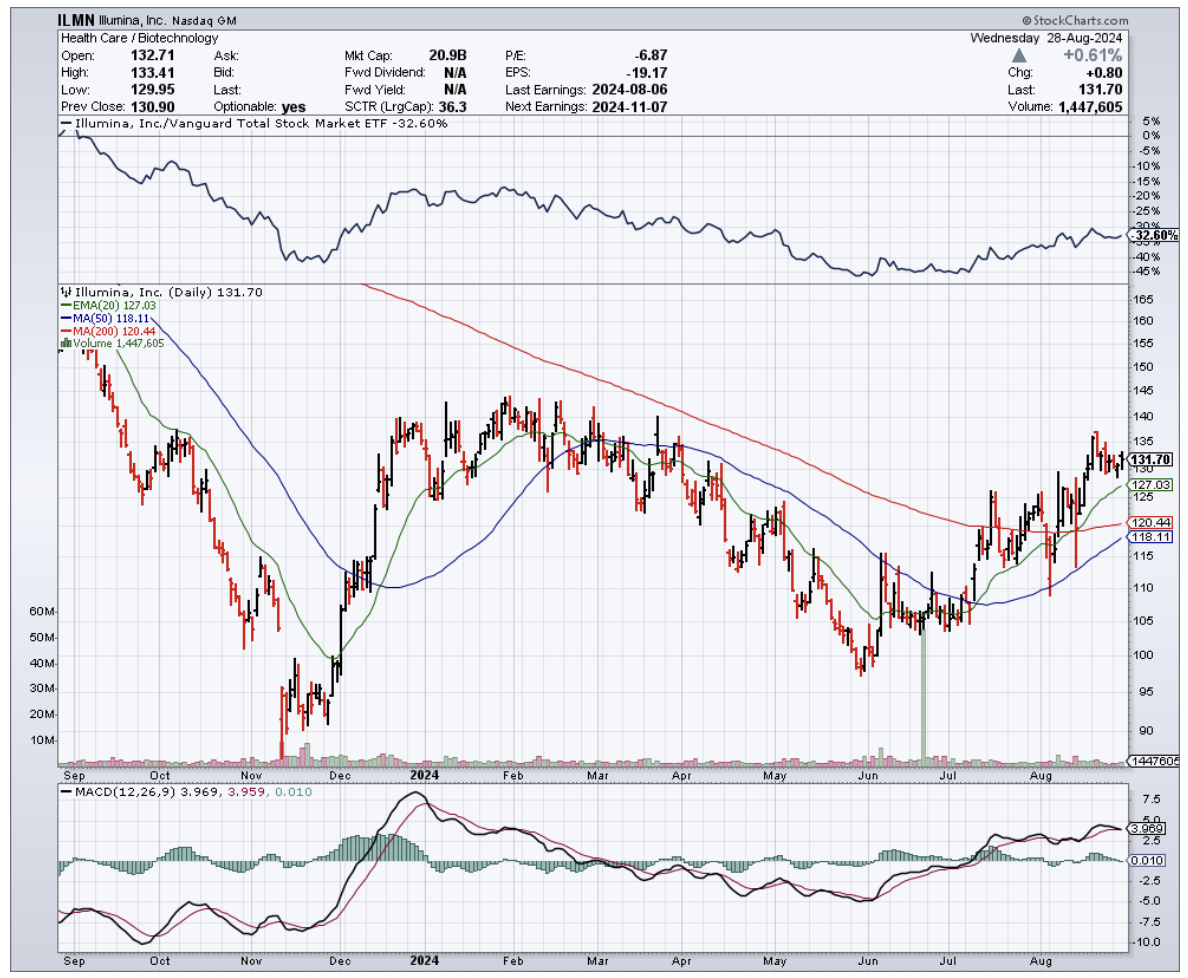
Legal Disclaimer
There is a very high degree of risk involved in trading. Past results are not indicative of future returns. MadHedgeFundTrader.com and all individuals affiliated with this site assume no responsibilities for your trading and investment results. The indicators, strategies, columns, articles and all other features are for educational purposes only and should not be construed as investment advice. Information for futures trading observations are obtained from sources believed to be reliable, but we do not warrant its completeness or accuracy, or warrant any results from the use of the information. Your use of the trading observations is entirely at your own risk and it is your sole responsibility to evaluate the accuracy, completeness and usefulness of the information. You must assess the risk of any trade with your broker and make your own independent decisions regarding any securities mentioned herein. Affiliates of MadHedgeFundTrader.com may have a position or effect transactions in the securities described herein (or options thereon) and/or otherwise employ trading strategies that may be consistent or inconsistent with the provided strategies.
This site uses cookies. By continuing to browse the site, you are agreeing to our use of cookies.
OKLearn moreWe may request cookies to be set on your device. We use cookies to let us know when you visit our websites, how you interact with us, to enrich your user experience, and to customize your relationship with our website.
Click on the different category headings to find out more. You can also change some of your preferences. Note that blocking some types of cookies may impact your experience on our websites and the services we are able to offer.
These cookies are strictly necessary to provide you with services available through our website and to use some of its features.
Because these cookies are strictly necessary to deliver the website, refuseing them will have impact how our site functions. You always can block or delete cookies by changing your browser settings and force blocking all cookies on this website. But this will always prompt you to accept/refuse cookies when revisiting our site.
We fully respect if you want to refuse cookies but to avoid asking you again and again kindly allow us to store a cookie for that. You are free to opt out any time or opt in for other cookies to get a better experience. If you refuse cookies we will remove all set cookies in our domain.
We provide you with a list of stored cookies on your computer in our domain so you can check what we stored. Due to security reasons we are not able to show or modify cookies from other domains. You can check these in your browser security settings.
These cookies collect information that is used either in aggregate form to help us understand how our website is being used or how effective our marketing campaigns are, or to help us customize our website and application for you in order to enhance your experience.
If you do not want that we track your visist to our site you can disable tracking in your browser here:
We also use different external services like Google Webfonts, Google Maps, and external Video providers. Since these providers may collect personal data like your IP address we allow you to block them here. Please be aware that this might heavily reduce the functionality and appearance of our site. Changes will take effect once you reload the page.
Google Webfont Settings:
Google Map Settings:
Vimeo and Youtube video embeds:
